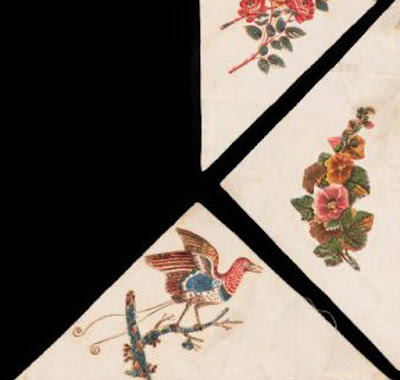Set of triangular blocks in the collection of Colonial Williamsburg.
Here's the online catalog information.
Printed Cotton Appliqued Document, ca. 1830Twenty-seven [pieces] that were never used. They were probably created with the intent to be made up into an appliqued quilt or quilt top.
Provenance: Ex-collection of Grace Hartshorn Westerfield (Mrs. Jason Westerfield) of Camden, Maine. No further provenance is known.
The pieces have been photographed on a black panel.
The bird in the lower left corner is a familiar print.
Bird with curly tail feathers in a South Carolina quilt dated 1847
in the MESDA collection.
The bird appears three times in this quilt by Johanna Davis of Charleston,
South Carolina, documented in the Kentucky project.
The center square
(the only square) is a vase of flowers, a
Chinese inspired design, distinctive with its curly knobs on the sides.
Colonial Williamsburg also has a set of 25 quilt blocks (quilt squares)
from a different donor.
Here's a simpler version from the same set and the curlicues have been trimmed.
These blocks descended in the Clarke/Porter family.
The collector is just as interesting as the triangular blocks. I first noticed her in the 1952 article from Life Magazine that I showed in the last post.
Grace Hartshorn (1885-1974) who married three times was known as Peggy. With her last husband Jason Westerfield (1878–1959) she lived in Camden, Maine where they restored vintage houses decorated with antiques. She was quite a collector of textiles, books, manuscripts and other antiquities.
In the last years of her life she made gifts to various institutions, including Colonial Williamsburg, where the triangular blocks above were given the year she died. She also donated to the Smithsonian, the Brooklyn Museum, Boston's Museum of Fine Arts, Colby and Bowdoin Colleges.
Life pictured her with one of her "rags" a cut-out chintz bedcover. At the time she was a source for fabric designers looking for what we might call document prints. According to Life they called them rags. (I've never heard anyone call these rags.)
We can assume a collector as devoted as Peggy Westerfield bought her treasures all over the world, so we have no idea where she found the blocks at the top of the page. But I'm guessing South Carolina or nearby.
We can thank her for her generosity and the time she and her executors spent in dispersing her collections.
Another of her gifts to Colonial Williamsburg is this 18th-
century English sample book currently on display.
In the last years of her life she made gifts to various institutions, including Colonial Williamsburg, where the triangular blocks above were given the year she died. She also donated to the Smithsonian, the Brooklyn Museum, Boston's Museum of Fine Arts, Colby and Bowdoin Colleges.
Life pictured her with one of her "rags" a cut-out chintz bedcover. At the time she was a source for fabric designers looking for what we might call document prints. According to Life they called them rags. (I've never heard anyone call these rags.)
Brooklyn Museum Costume Collection at
The Metropolitan Museum of Art, Gift of the Brooklyn Museum, 2009;
Gift of The Jason and Peggy Westerfield Collection, 1969
Shaded blue and buff wrapper from her collection.
Westerfield donated many articles of dress to the Brooklyn Museum in 1969. In 2009 the Brooklyn collection was moved to the Metropolitan Museum of Art. Well over a hundred items in the Costume Collection are from her.
"Lord Charlemont at the Provincial Review in Phoenix Park,
Dublin, June 3, 1782" An Irish print.
Boston Museum of Fine Arts. Donated in 1958.
She also donated a 1950s reproduction of this print from Greef Fabrics to the Museum of Fine Arts.
A Greef reproduction called Parakeet.
They did a line called Document Hill with prints
from Westerfield's collections.
We can thank her for her generosity and the time she and her executors spent in dispersing her collections.
From the Brooklyn Museum Collection
















Thanks for sharing. I think Peggy had a fun 'hobby', collecting and restoring.
ReplyDelete